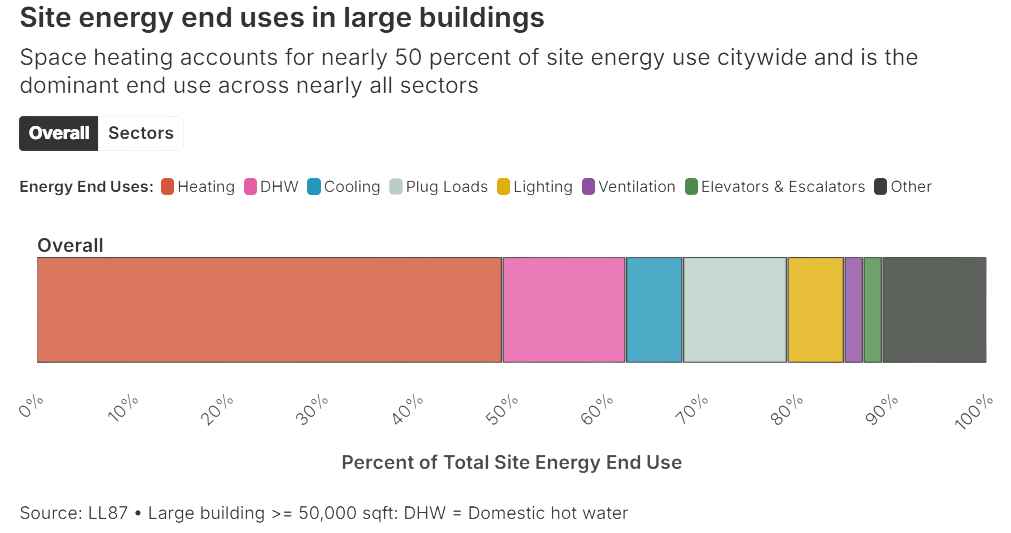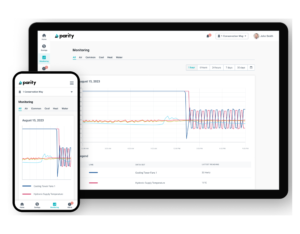Building Performance Standards like NYC’s Local Law 97, Boston’s BERDO, and the DMV’s BEPS aren’t going anywhere. And they’re only growing stronger.
A three-year legal challenge by two co-ops to overturn NYC’s Local Law 97 was just dismissed by the state’s highest court on May 22, 2025, sending a clear message to property managers that building performance standards are here to stay.
Building performance standards are designed to curb greenhouse gas emissions and improve energy efficiency in large buildings. While they differ across cities, their core goals are the same: reduce carbon emissions, modernize building operations, and help cities meet ambitious climate targets.
Legal and Political Pushback
The rollout of building performance standards hasn’t been without resistance.
There have been legal challenges, including a high-profile lawsuit from two co-ops seeking to block the law entirely. That suit was dismissed by the state’s highest court in May 2025, reinforcing that Local Law 97 is here to stay.
However, the deadline for the first round of Local Law 97 compliance reporting was extended from May 1st to August 29th, with an option to file for extension to December 31, 2025, giving buildings more time to prepare.
In Washington, D.C., similar tension is playing out. The Mayor’s proposed FY2026 budget calls for significant delays to the city’s Building Energy Performance Standards (BEPS). The first compliance deadline, originally set for 2026, would be pushed back to 2032.
Future BEPS cycles would also be delayed, and related net-zero energy requirements could be postponed until 2045. While these proposals are not yet finalized and still require Council approval, they’ve created real uncertainty for building owners, operators, and service providers across the District.
Boston, by contrast, is staying the course. Under BERDO 2.0, large buildings are already required to report their emissions, and emissions caps are set to start phasing in by 2025 for many property types. The city has also committed to releasing detailed enforcement guidance and penalty structures, signaling that BERDO compliance is moving forward as planned.
Despite differing timelines, the overall direction is consistent. Cities remain committed to cutting emissions, and building performance standards continue to be the tool they’re using to get there.

Source: energycodes.gov/BPS, April 2024
Why Building Performance Standards Still Matter
It’s easy to get caught up in shifting deadlines and legal battles. But at their core, building performance standards is about something more permanent: accountability.
These policies are forcing the real estate industry to confront energy use and emissions in ways that are measurable, transparent, and tied to real outcomes. Whether your city is slowing down or doubling down on building performance standards, the inevitable outcome remains the same.
Also, models like New York’s “Good Faith Efforts” approach, where buildings that aren’t fully compliant can reduce penalties by demonstrating real planning and progress, are emerging as a template for how enforcement might evolve across other cities, too.
Building performance standards will redefine what it means to operate a high-performing building by rewarding the buildings that take action and penalizing those that don’t.
The Practical Path Forward
So what does meaningful, proactive compliance look like in practice?
It starts with understanding your building’s performance. You can’t improve what you haven’t measured, which is why an energy audit is the critical first step.
This step is about understanding how your building truly performs: where energy is being wasted, where systems are falling short, and where opportunities are. Done right, this sets the foundation for everything that follows.
Once you know your baseline, prioritize smart, high-impact upgrades that make sense both financially and operationally. The most successful strategies don’t rely on major capital projects from day one. Instead, they focus on getting more out of what you already have. That could mean:
These actions are cost-effective and build momentum. They demonstrate intent, show progress, and create early wins that are easy to communicate to boards, tenants, and regulators.

Documentation matters just as much as implementation. A well-documented process showing audits, vendor proposals, completed scopes of work, and performance improvements provides evidence of compliance.
In cities like New York, that’s what qualifies as a “good faith effort.” But even beyond compliance, it becomes your case for future investment and board buy-in.
The takeaway is clear for building owners and managers across the U.S: timelines may shift, but the expectation to act remains firmly in place.
The Parity Difference
Parity makes the process of navigating building performance standards smoother. Our HVAC optimization service integrates with your existing systems to reduce energy usage and emissions while providing clear, actionable data. Comprehensive reports simplify compliance documentation and show your building’s path forward.
Learn how Parity can help your building stay ahead of the curve. Visit our website to discover how Parity helps buildings reduce GHG emissions to meet building performance standards without ripping and replacing equipment.
Or, email contact@paritygo.com or call 1-833-372-7489 to see if your building is a good fit for our services.
Leading HVAC Optimization as a Service company appoints Jerremy Spillman to drive West Coast growth amid soaring Californian utility rates and grid challenges.
Toronto, ON – May 12th, 2025 – Parity, the leader in Remote HVAC Optimization as a Service for multifamily buildings and hotels, has expanded into California. This marks a major milestone in its U.S. growth strategy. The focus on the state is anchored by the appointment of Jerremy Spillman, former Senior Director of Sales at JLL Technologies and Co-Founder of Hank, who joins Parity as Director of West Coast Operations.
Parity is quickly approaching 100 million square feet of real estate under management and raised $19 million in Series B funding last year. Trusted by many of North America’s largest real estate owners, operators, and investors, Parity’s AI-driven HVAC automation platform remotely optimizes building systems in real time, slashing energy waste by up to 30% and maximizing demand response revenue.
California, facing steep utility rates and mounting grid strain, is a prime market for Parity’s solution. Electricity rates in California have risen over 70% in the past decade, and summer peak loads are expected to push the grid to new limits in 2025. Parity’s expansion into California positions it at the center of a market that is actively searching for ways to reduce costs, emissions, and grid strain.
“California is a market we have been excited about entering since Parity first expanded to the United States.” Said James Hannah, Managing Director, U.S., at Parity, “The combination of increasingly high utility rates and the growing need for buildings to more intelligently interact with the electric grid makes California a natural fit for Parity’s services. Our platform not only helps building owners and operators reduce energy costs and emissions, but also transforms their properties into smarter, grid-responsive assets. We feel confident entering the market, as we have proven results across North America, positioning us to support the state’s ambitious energy and climate goals.”
California continues to push towards electrification and grid decarbonization; Parity’s AI-driven HVAC optimization platform is positioned to help buildings evolve into Grid-Interactive Efficient Buildings (GEBs). GEBs allow dynamic interaction with the grid, allowing HVAC systems to change energy usage to off-peak times, lower costs, cut emissions, and participate in demand response programs. By utilizing Parity, this is done automatically and without compromising occupant comfort.
“We have had our sights set on a West Coast expansion ever since entering the U.S. market in 2020,” said Brad Pilgrim, Co-Founder and CEO at Parity. “After meeting Jerremy Spillman, we knew we were ready to hit the ground running. Jerremy not only brings years of experience in HVAC optimization and energy efficiency, but also the entrepreneurial mindset needed to help Parity scale successfully in this new market. His background in growing an impactful building technology company gives him a unique understanding of both the opportunities and challenges ahead.
Spillman brings over a decade of experience in real estate, energy efficiency, and building technology. Before his time at JLL Technologies, he founded Hank, a cloud-based HVAC optimization platform, acquired by JLL in 2021. Spillman previously held leadership positions at FreeWire Technologies and Direct Technology.
“I have spent the last decade focused on solving energy and sustainability challenges in commercial real estate,” said Jerremy Spillman, Director of West Coast Operations at Parity. “Parity delivers results, significant savings for owners, and operational ease for building operators. With energy costs climbing and grid stability becoming increasingly important. Parity’s solution is exactly what the California multifamily market needs right now.”
This expansion follows a year of major momentum, including Parity’s Series B funding round aimed at scaling into new markets and verticals. As building owners look to future-proof assets, reduce operational costs, and meet sustainability goals, Parity’s HVAC Optimization as a Service model provides a solution that delivers guaranteed savings.
The landscape of property management is quickly evolving. Energy prices are rising, emission caps are tightening, and buildings that once coasted on predictable energy budgets are finding themselves exposed.
As grid strain intensifies and energy prices become more volatile, one thing is clear: the old way of managing HVAC systems is no longer economically viable.
This shift demands a change in mindset on how we think about utility costs. If you’re serious about cutting utility costs, you have to start with the system that drives most of them.
In most large residential buildings, the biggest opportunity for cost reduction is hiding in plain sight – your HVAC systems.
When buildings need to cut utility costs, they often start with what’s visible: swapping light fixtures, upgrading thermostats, etc. These efforts help, but they miss the bigger picture.
The largest share of utility costs in most residential buildings isn’t lighting or plug loads. It’s HVAC.
Heating, cooling, and ventilation systems operate continuously, reactively, and often inefficiently. They’re the foundation of a building’s energy profile and the source of the greatest waste.

Source: Urban Green Council
Unlike traditional efficiency upgrades that focus on hardware replacement or marginal improvements, HVAC optimization doesn’t only address what consumes energy, it addresses how energy is consumed. It does this through intelligent software that can:
And it does all this without having to tear out existing equipment. Because HVAC optimization, like Parity’s Optimizer service, is software-based and hardware-light, it builds on your existing systems without having to replace them.
The financial impact of HVAC optimization is immediate, measurable, and substantial. By aligning HVAC operation with real-time demand, weather, and utility pricing, buildings reduce both total energy consumption and costly peak demand charges.
When executed properly, the benefits of HVAC Optimization are pretty easy to see: they show up directly on utility bills, often within the first few billing cycles.
Beyond the utility bill, these results translate into fewer emergency repairs, longer equipment lifespans, and progress toward emissions compliance. In several cases, optimization also unlocked participation in demand response programs turning HVAC from a cost into an asset.
Parity helps buildings save on utility costs through real-time HVAC optimization – guaranteed.
At 252 East 57th Street, a luxury condo in New York City, Parity delivered over $165K in first-year savings and achieved the full payback in only 8 months.
Across town, Avalon Clinton South, a 24-story rental building, saved more than $145K in energy costs within its first year, hitting their ROI in under 9 months.
Meanwhile, 401 East 86th Street, a 229-unit co-op, realized $107K in annual savings with a 2-month ROI.
If you want to learn more about how Parity is helping property and asset managers navigate energy efficiency and carbon fines, email contact@paritygo.com or call 1-833-372-7489.
Modern buildings generate massive amounts of data from HVAC systems, water usage, occupancy patterns, and more. But data alone isn’t enough. The key is to turn that data into actionable insights to improve efficiency, reduce costs, and enhance resident comfort.
That’s where data-driven HVAC optimization comes into play. By continuously monitoring a building’s HVAC performance and using real-time analytics, inefficiencies can be identified.
Maintenance needs can be predicted, and adjustments can be automated to save money and energy.
Heating and cooling systems are one of the largest energy expenses in residential buildings, often accounting for nearly 50% of total energy use. Without real-time monitoring, buildings may overheat, overcool, or run equipment inefficiently. That leads to wasted energy and unnecessary costs.
With data-driven HVAC optimization, buildings can reduce energy waste by utilizing software that makes automatic control adjustments based on real-time conditions.
Equipment lifespans can be extended by preventing overuse and catching small maintenance issues. Utility bills can be lowered when HVAC equipment only runs when necessary, rather than operating on outdated, fixed schedules.
At the same time, resident comfort remains a priority. Smarter controls can eliminate sudden fluctuations and uneven heating or cooling. That means fewer complaints from residents.

Traditional HVAC maintenance follows a fixed schedule or responds to failures after they happen. This means that systems may receive maintenance too late, after damage is done. Maintenance can be done too early, wasting time and resources.
Proactive maintenance changes the game by using real-time data and historical trends to detect subtle shifts in performance before a breakdown occurs.
By continuously analyzing HVAC data, predictive systems can flag equipment inefficiencies, prevent unexpected downtime, and reduce emergency repairs.
If a boiler starts running cold, ventilation system begins overworking, or a chiller shows signs of strain, building managers can take action before the problem escalates. This reduces maintenance costs, improves system reliability, and prevents disruptions for residents.

Parity remotely controls and optimizes HVAC systems to guarantee utility cost savings for multifamily residential buildings and hotels, with no upfront investment.
We help buildings reduce their energy waste, lower operational costs, and monitor their HVAC systems. By continuously monitoring HVAC systems, Parity can identify inefficiencies, optimize system performance, and send real-time alerts to building managers before issues become problems.
With Parity, buildings can:
By embracing real-time data and cutting-edge technology, buildings that work with Parity can unlock significant cost savings and long-term efficiency gains.
To learn more about how Parity is bringing advanced HVAC technology into the residential space, email contact@paritygo.com. You can also visit our website to learn more.